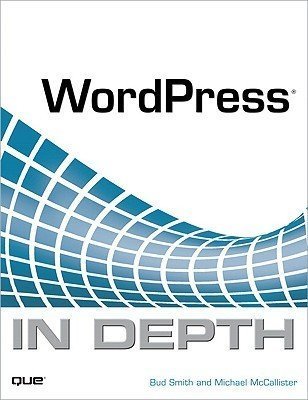
WordPress In Depth by Bud E. Smith
My rating: 3 of 5 stars
Note: This page contains affiliate links. Please see Affiliate Disclosure.
Based on the title, I expected to be overwhelmed by the “in depth”, technical details of WordPress. Instead, I was bored by the first 3 parts, which are mainly aimed at novice WordPress.com bloggers, and explain posts, graphics, links, and content creation. I was relieved to find that Part IV speaks to WordPress designers and developers, briefly covering themes, plugins, CSS, and PHP. Still, each topic is only given a few pages.
The authors claim that the “in depth” part of the title refers to the fact that they explain the “why”, not just the “how”; they explain the history behind the technology, and the rationale for certain design and development choices. The book briefly reveals the Web’s history, and concisely describes the origin and development of HTML, CSS, PHP, the GPL, and web standards.
There are too many sidebars that distract from the main text, but I liked the text font and the layout is otherwise decent. The appendices are fairly useless; they explain the difference between WordPress.com and WordPress.org, list documentation resources, and exhibit examples of WordPress sites.
Anyone except a complete WordPress newbie should skip straight to Part IV. The authors point out several excellent WordPress resources, so it's worth reading that part just for those.
Notes
Media Settings
thumbnail: 80 x 80
medium: 200 x 200
large: 400 x 400
Categories
Categories are like the table of contents (topics). Tags are like the index (keywords).
Limit categories to 4, or 12 max.
Use a single level; no subcategories.
Put each post in a single category.
Free WordPress themes
WordPress.org Free Themes Directory
Weblog Tools Collection
Commercial WordPress themes
WordPress.org Commercially Supported GPL Themes
iThemes
Themeforest
Thesis
WooThemes
WP Remix
Free WordPress plugins
WordPress.org Plugin Directory
Weblog Tools Collection
Recommended WordPress plugins
Administration and Security plugins
Update Notifier
WordPress File Monitor
WB-DB-Backup
Exploit Scanner
Statistics plugins
Google Analytics for WordPress
Comments plugins
IntenseDebate Comments
Disqus Comment System
Subscribe to Comments
AJAX Comments
SEO plugins
Google XML Sitemaps
All in One SEO Pack
Links plugins
AddToAny
Sociable
ShareThis
Permissions
The wp-content directory and its contents should be 775. The owner should be the WordPress user.
Theme files should be group-writable.
Additional notes
“new” and “free” are the most powerful words in marketing. Use them on your site.
Use XAMPP to create a local environment.